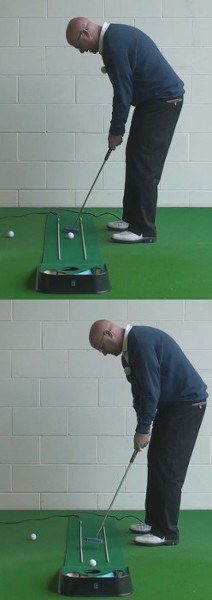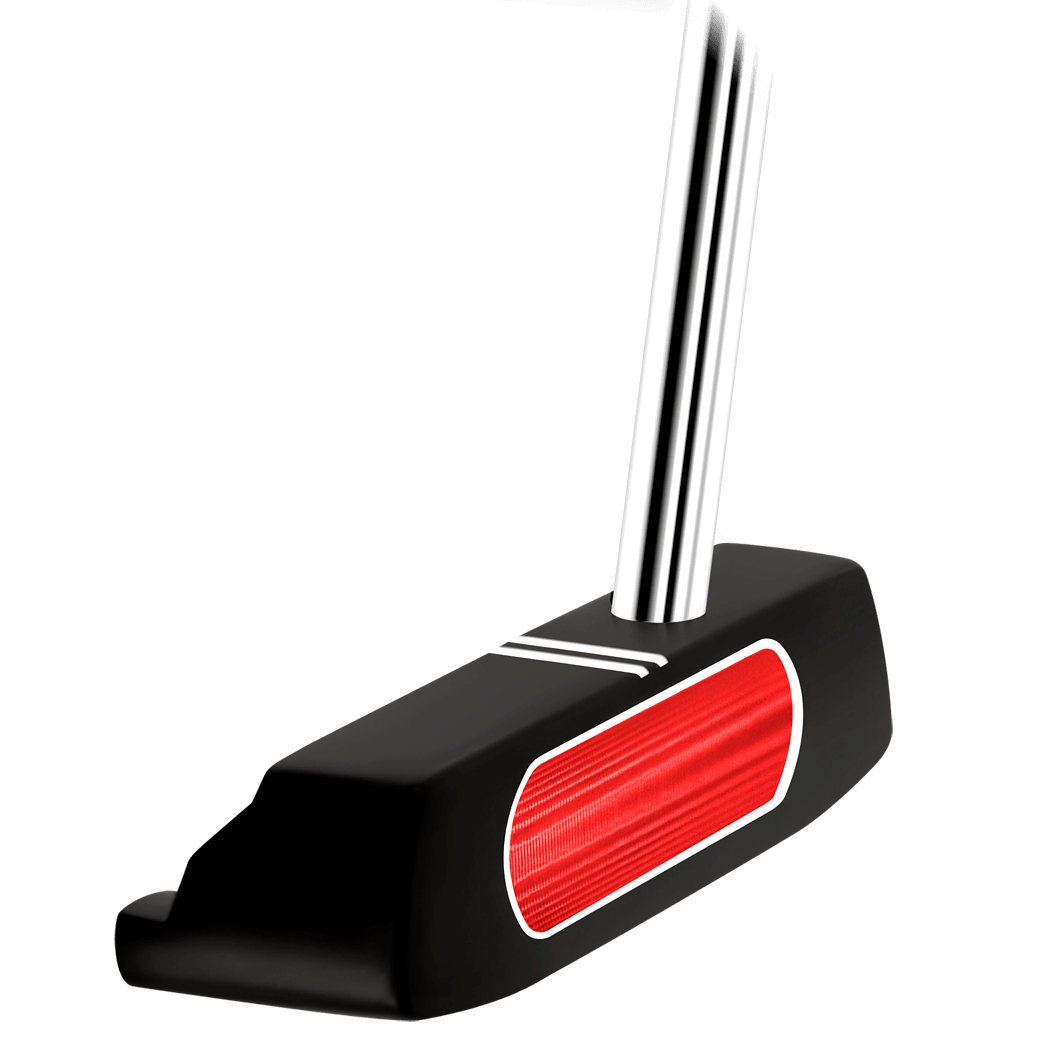
The key to good putting is to make sure the golf ball rolls smoothly when you stroke it.
A bad action will cause the golf ball to jump when being struck. This leads to the golf ball deviating off line as the ball hops and skips across the putting green. A good putting action stays smooth and rolls true across the putting green and does not deviate off line, so has a much better chance of heading into the hole.
Fault - If the putting action changes rhythm during the stroke, the golf ball can fire off the club face, or on the other hand, can trickle off the face with no power. The main reason why this happens is the fact the backswing and the follow through are different lengths and happen at very different speeds as a result.
Fix - To promote the best possible ball roll, the stroke must be smooth and slightly upward hitting on the golf ball. To help hit slightly on the way up, the golf ball should be placed just in front of the middle of your stance. In order to promote the best tempo and rhythm during the stroke, it is important that the backstroke and follow through are symmetrical to each other.
Key practice tip - The best way to help with the consistency and speed of your putting stroke would be to practice with or imagine using a metronome set at 80 beats per minute (BPM). A metronome is a device that produces regular, metrical ticks, beats or clicks - settable in beats per minute. These ticks represent a fixed, regular aural pulse. You can purchase a metronome or download an application on to your 'phone. The idea is to practice your stroke to the same 80 BPM beat as the metronome keeps the backswing and follow through the same length. Once you have practiced the stroke without a golf ball using the metronome, move on to hitting some putts with a golf ball along the putting green, not really worrying about where the golf ball goes, just aiming to keep the tempo and the rhythm the same as the metronomic stroke.
Top tip - When getting ready to take your putt, aim to make two or three rhythmic practice strokes as close as you can to actually taking the real shot. This way the rhythm and tempo is fresh in your mind ready to do the same when it comes to the real putt.

How to Create a Smoother Rolling Putt
The objective is clear anytime you step onto the green – roll your ball into the hole in as few strokes as possible. But how do you do that? Certainly, getting a good read on the putt is part of the challenge. Also, you need to be able to set aside your nerves so you can hit a good putt despite any pressure that you might be feeling. There is a lot that goes into a good putt, which is why it is no surprise when amateurs or professionals struggle with this tricky part of the game.
One area of putting which is often overlooked is the task of rolling the ball smoothly toward the hole time after time. Even if you don't notice, your putts actually get airborne for a very brief period of time when they leave the face of the putter. All putters have some loft – usually around 3* - and that loft is going to get the ball just barely off the ground before it comes back down and rolls out. If you can make a stroke which encourages a smooth transition from the face of the club onto the turf, you will roll beautiful putts that have a higher chance of falling in the cup.
It is easier to see this bouncing phenomenon when you get farther away from the hole. During your next practice session, hit a long putt across the entire length of the green. Pay particular attention to the ball just after it leaves the putter – most likely, you will be able to see it skidding for a short distance before starting to roll. The player who can limit the amount of skidding on their putts is going to be a step ahead of the competition.
Why is skidding a bad thing on the greens? It comes down to holding your line. Once you have taken the time to pick out the perfect line for your upcoming putt, you will then want to hit that line as accurately as possible in order to give the ball a chance to fall in. If the ball skids badly off your blade, it is likely that the ball will bounce off line to a degree before settling down. By trading some of that skid out for more roll, you will have a better chance of hitting your line – and your putts will have a better chance of successfully reaching their destination.
In this article, we are going to offer some advice on how you can create a smoother rolling putt in your own game. You may need to make some technical changes to your stroke in order to create a smoother roll, but these changes should be pretty easy to implement and you should be up and running with your new putting mechanics in short order. Once you have mastered the ability to roll the ball smoothly, you may be surprised to find how many more of your putts drop in the hole rather than missing just off the edge.
All of the instruction in this article is based on a right-handed golfer. If you happen to play left-handed, please take a moment to reverse the directions as necessary.

The Many Benefits of a Smooth Roll
We already talked some in the introduction about how a smooth-rolling putt can help you achieve excellent results on the greens. In this section, we are going to look a little further into that topic, as understanding why this is important will help you stay motivated to work on it over time. All golfers want to putt their best as often as possible, and being able to roll your ball smoothly along the top of the grass will help you do just that.
- Holding your intended line. This is the main point which was made in the introduction. A ball which is rolled smoothly off the face of the putter is going to have an easier time holding its line, which means you will be able to take advantage of your accurate reads more frequently. There are few things in golf quite as frustrating as reading a putt perfectly, only to miss your line with a poor stroke and watch the ball slide by the cup. With a smooth roll, you should experience this frustration less often, and your scores should come down.
- Dialing in your distance. Most golfers obsess over their target line while putting, but it is just as important to get your distance correct. Rolling the ball the right distance is one of the inherent challenges in putting, and it can be difficult to do if you are skidding the ball toward the target with most of your strokes. A clean roll is easier to predict, meaning you should be able to dial up the right speed most of the time. As you begin to roll the ball better and better, you should notice that your ability to control speed almost immediately improves.
- Avoiding the big bounce. One of the worst things that can happen to you on a long putt is to have the ball bounce up into the air shortly after leaving the blade of your putter. If you hit a skidding putt, and the ball hits an uneven spot on the turf while it is skidding, you might get a big bounce – and in the end, the ball will come up way short of the target. When the ball is rolling smoothly along the turf, you won't need to worry so much about this issue. A ball which is rolling nicely on the ground will do a better job of making its way over the inconsistencies in the green, giving you a better result in the end. There is nothing you can do to totally take away the issue of an uneven green, but achieve a clean roll is a great start.
- Consistency on short putts. Making all – or at least most – of your short putts is one of the keys to posting a good score in this game. Golf is too hard to give away strokes from within three feet and still expect to finish the day with a number that you like on the scorecard. By rolling the ball smoothly off the putter, you can increase the number of short putts that you make on a regular basis. A bouncing ball is an unpredictable ball, so you are more likely to see your putt veer off line from short range if the ball is skidding. If for no other reason, learn how to roll the ball cleanly off the face so you can make as many short putts as possible in each round.
There is a lot that you stand to gain by learning how to roll the ball smoothly along the ground when you putt. Sure, there is going to be some work involved in learning to achieve a smooth roll, but you will be rewarded for that work when you see your scores begin to fall in upcoming rounds. Commit yourself to some focused practice time, using the tips we are going to provide later in this article, and you will be on your way to a new level of performance on the greens.

Mechanical Keys
Now that you have a clear understanding of just how important it is to roll the ball smoothly on the grass, it is now time to take a look at your putting technique. Most likely, you are currently making at least one or two mistakes which are making it difficult for the ball to roll along the grass smoothly. That is not a criticism of you specifically – it is just a fact of life in the amateur golf game. Most players have a problem or two in their technique, and correcting those errors will quickly lead to better outcomes.
The list below includes four mechanical keys that you should keep in mind while trying to create a smooth roll. If you are able to hit on all of these points, it is nearly certain that your putting will take a big step forward.
- Use soft hands. This might be the most important putting tip that you can receive. When swinging your putter back and through, you need to do a good job of keeping your hands and soft and relaxed as they can be. If you allow your grip to get tight around the putter, there will be tension in your hands and you will be likely to hit at the ball aggressively at impact. That is not the result you are looking for. Instead, you want to swing the putter cleanly through the ball, without any sense of a 'hit' at the point of contact. Make sure your hands and fingers are relaxed around the grip of the putter at address, and then keep them that way throughout the entire stroke.
- Play the ball forward in your stance. Surprisingly, your putting stroke has a fair amount in common with your driver swing. Specifically, you want to be hitting up on the ball slightly at impact with both of these clubs. To make sure you can hit up effectively, the ball should be placed forward in your stance at address, near the inside of your left foot. Too many golfers putt with the ball in the middle of their stance, and they wind up hitting down slightly as a result. Hitting down is great for iron shots, but it is going to cause a poor roll when trying to putt. Keep the ball up near the front of your stance and let the putter head swing up slightly through impact to achieve a beautiful roll. Once you get comfortable with this kind of technique, you will probably wonder how you ever putted any other way.
- Hold your head perfectly still. It might not seem that such a simple tip could actually help you putt better, but holding your head still is one of the keys to a great roll. By holding your head in the same position throughout the stroke, you are actually going to encourage the rest of your body to stay still as well – and that is critical to success on the greens. Good putters are able to take as many moving parts out of the stroke as possible, and you can do just that by holding your head stable while the putter swings. Make sure to get into a comfortable position over the ball prior to starting the stroke, and then let the club rock back and through toward the target. Keep things simple and you are far more likely to be happy with the outcome of your putts.
- Finish the stroke. One of the easy ways to end up with a poor roll is to simply give up on your stroke before it is finished. Some golfers quit moving the putter as soon as they touch the ball – basically punching the ball toward the target. Needless to say, this is a mistake. Just as is the case with your full swing, the follow through matters when putting. Commit yourself to swinging the putter all the way through the ball, and hold your finish position carefully while the ball rolls. If you are willing to go all the way to a balanced finish each time, the ball will come off cleanly and your roll should improve.
With these four tips in mind, there is only one thing left to do – get out and work on your putting stroke at the local golf course. For your next practice session, consider leaving your full swing clubs at home while just taking a putter and a handful of golf balls. You aren't going to make any improvements until you dedicate some practice time to this area of your game, so get down to work and watch your results trend in the right direction.

Having the Right Attitude
Believe it or not, your attitude toward putting can actually have an effect on how well you roll the ball across the green. Your mind set is important in all of the various facets of golf, but it might be most important when you are standing on the putting surfaces. Without the right attitude, and plenty of self-confidence, it will be hard to roll the ball with any degree of consistency.
The first thing you need to understand about putting is that you are going to miss some of your putts – it's inevitable. That's right – to be a good putter, you actually need to accept the fact that you will miss along the way. Have you ever had 18 putts in a complete round of golf? Probably not. Even totally 25 putts during an 18-hole round is an impressive effort, and that total means you missed seven along the way. By accepting the fact that it is okay to miss, you will put less pressure on yourself while standing over the ball. Less pressure is going to lead to a free stroke, and a free stroke will usually result in a smooth roll.
While you do need to be okay with the idea of missing some of your putts, you also need to be optimistic about your chances. This is where many amateur golfers go wrong. They go too far in the other direction, thinking they are going to miss each and every putt they attempt. You are never going to make all of your putts, and you are never going to miss all of your putts, either. Each time you prepare to putt, you should stand over the ball expecting to hit a great putt toward the hole. You might not make every one of them, but you should still expect to do your job properly.
It is important to be optimistic because that feeling will likely lead to an aggressive, accelerating motion through the ball. When the putter picks up speed as it moves toward the hole, you will have a good chance to impart a smooth roll on the putt, and the ball should stay low to the ground as a result. In this way, your mindset is going to directly affect the mechanics of your stroke, and the roll of the ball. Mind and body are closely connected in this difficult game, and perhaps nowhere is that concept more prevalent than when trying to perform well on the greens.

Other Putting Keys
As you know, putting is a complicated topic. Yes, it is important to roll the ball smoothly along the ground, but there are other important elements to hit part of the game as well. In this last section, we are going to highlight some of the other keys you will want to focus on with regard to your putting game. Add these keys to a smooth roll and the sky will be the limit.
- Putt from the low side. This isn't actually a putting tip so much as it is a course management tip. If you can manage to place your ball on the low side of the hole more often than not, you will frequently be facing uphill putts – and it is almost always easier to putt uphill as compared to downhill. You can be more aggressive with your uphill putts, as you won't need to worry about racing the ball past the cup. Also, if you do miss the green with your approach shot, you will be chipping uphill rather than dealing with a fast downhill pitch. Do your best to keep the ball on the low side of the hole and the entire game will get easier.
- Play more break. Generally speaking, amateur golfers do not read enough break into their putts. The majority of weekend players read the minimum amount of break into their putts before hitting the ball hard in the hopes that it will hold the line. This is usually a losing strategy. Instead of this approach, try playing more break and using less speed so the ball has time to turn into the hole. You will give yourself more room to work with when taking this option, and your misses will stop closer to the hole for an easier second putt as well.
- Hit as many short putts as possible. Repetition is the key to success on short putts. If you never hit any short putts in practice, it is highly unlikely that you will be able to hole them out on the course. Try starting and finishing each practice session with just a few minutes of putting practice from inside five feet. With these repetitions under your belt, you will feel far more confident on the course when you are faced with a difficult short putt to save your par.
- Stick with your putter. What do you do after you have a couple of poor rounds with the putter? If you are like most golfers, you get online and start shopping for a new flat stick. Sadly, this cycle can continue for years and you may never settle on a putter that you decide you like. Instead of blaming your equipment after a poor round, head to the practice putting green to work on your technical flaws. Most likely, the putter you already have in your bag will work just fine when you make the right stroke and match it up with the right read.
Rolling the ball smoothly along the top of the grass is going to make it much easier to make your fair share of putts during an average round. You won't automatically be a great putter when you roll the ball smoothly, as other skills like green reading, steady nerves, and touch come into the picture as well. However, a good roll is going to give you a great start, and you can work on building up your performance from that point. We hope the advice provided in this article will send you down the right path toward improved putting performance. Good luck!







